Br3– is an anion and are chemically called tribromide anion due to the presence of 3 Br atoms and a negative charge. Here we will discuss about the Br3- Lewis structure and also 13 facts we must know about it.
In Br3– lewis structure the central Br atom has 3 lone pair of electrons and 2 bond pairs bonded to 2 surrounding Br atoms. It is sp3d hybridised with linear shape having bond angle 180o. The formal charge of central bromine atom is found to be -1.
Br3- valence electrons
The valence electron number of Br3– is 22.
In Br3– there are 3 Br atoms and it belongs to the 17th group of the periodic table. The valence electron of an atom is 10 minus its group number and so,
Valence electron of Br atom = 17-10 =7
There are 3 Br atoms in Br3– and also a negative charge so,
The total valence electrons of Br3– = 3 (7) +1 =21 +1 = 22
How to draw Br3- lewis structure?
In Br3- Lewis structure the central atom Br has 3 lone pair of electrons and is bonded to surrounding 2 Br atoms.
1)Count the total number of valence electrons of the compound.
Total valence electron number of Br3– is 22 (21 electrons from 3 Br atoms and 1 electron from negative charge).
2)Select the least electronegative atom as the central atom and place remaining atoms around it.
Here in Br3– all the 3 atoms are Br and hence have same electronegativity so choose anyone among the 3 as the central atom place it in the centre and remaining atoms around it.
Br Br Br
3)Now the surrounding atoms are singly bonded to central atom by pairing its electrons.
Br : Br : Br
4)The remaining valence electrons after bonding are placed around the atoms to complete its octet.
From 22 valence electrons 4 electrons are used for bonding and so from the remaining 18 electrons each surrounding Br atom will take 6 electrons each to complete it octet ie. A total of 12 electrons are taken by the surrounding Br atom.
The remaining 6 electrons are placed on the central atom Br.
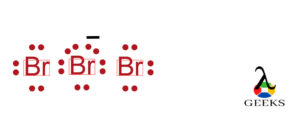
5)Mark the charges on the Lewis structure by drawing a bracket if present.
According to Lewis structure, the charge should be present on the central atom and it should be indicated by drawing a bracket and marking the charge.
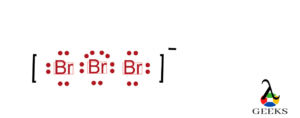
6) Count the number of electrons present on the central atom and the surrounding atoms after bond formation.
The central Br atom has a total of 10 electrons (4 from single bond formed with 2 Br atoms and 6 from non-bonding electrons). The surrounding each Br atom has a 8 electrons each (2 from bond formed with central Br atom and 6 from non-bonding electrons). Thus, completing its octet.
Br3- lewis structure lone pairs
From Br3- Lewis structure the central Br atom has 3 lone pair of electrons i.e. 6 non-bonding electrons and the outer 2 Br atoms bonded to central atom has 6 lone pair of electrons (12 non-bonding electrons) each bromine atom taking 3 lone pair of electrons.
Br3- lewis structure octet rule
In Br3– the central atom Br has 10 electrons more than the electrons required for octet rule which is to have 8 electrons in its valence shell.
Br atom can have an expanded octet because it belongs to the 4th period in the periodic table and hence, they have empty d orbitals that can accept more electrons. That is Br has 10 electrons in its valence shell.
Br3- lewis structure formal charge
The formal charge of central atom Br is -1 and the surrounding 2 Br atoms is 0.
Formal charge on an atom in a Lewis structure = total no. of valence electrons in the free atom -the total number of non-bonding (lone pair) electrons -half the total number of bonding electrons.
Total number of valence electrons in bromine atom = 7
Formal charge of 1st Bromine atom
Total number of non-bonding electrons = 6
Total number of bonding electrons =2
Formal charge = 7–6–2/2 = 7-7=0
Therefore, the formal charge of 1st bromine atom is = 0
Formal charge of 2nd Bromine atom
Total number of non-bonding electrons = 6
Total number of bonding electrons = 4
Formal charge = 7-6- 4/2 =7-8 = -1
Therefore, formal charge of 2nd bromine atom = -1
Formal charge of 3rd Bromine atom
Total number of non-bonding electrons = 6
Total number of bonding electrons = 2
Formal charge = 7–6– 2/2 = 7-7=0
Therefore, the formal charge of 3st bromine atom is = 0
Br3- hybridization
The hybridisation 0f Br3– anion is sp3d hybridisation.
there are 3 Br atoms in Br3– so let the 1st, 2nd and 3rd bromine atom be aBr, bBr and Br–
Electronic configuration of aBr is [Ar] 3d104s24p54d0
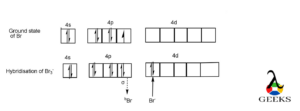
From the above diagram we can see that the bBr forms sigma bond with the unpaired electron present in the 4 p orbital of aBr.
In Br– atom there are a total of 4 pair of electrons. 1 electron pair from 4s and 3 electron pairs from 4p orbitals
Electronic configuration of Br is [Ar] 3d104s24p54d0
Electronic configuration of Br– is [Ar] 3d104s24p64d0
Br– ion will donate its 1 electron pair to 4d orbitals of aBr through coordinate bond. The characteristic of this bond will be similar to that of a sigma bond between aBr and bBr.

Thus, they will have sp3d hybridization.
Br3- lewis structure shape
The shape of Br3– anion is linear shaped with distorted trigonal bipyramidal geometry.
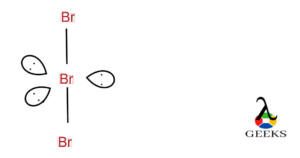
As Br3– is sp3d hybridised and has 3 lone pair of electrons in the central atom Br so its geometry will be Trigonal bipyramidal.
Since there are 3 lone pair of electrons in Br atom, they will repel will each other and will try to locate as far as possible at the equatorial position of central Br because of that it will have linear shape and will have a distorted trigonal bipyramidal geometry.
Br3- lewis structure angle
The bond angle between the two outer bromine atoms in Br3– is 180o with linear shape.
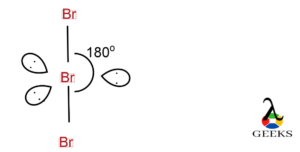
The central Br atom has 3 lone pair of electrons which will repel with each other and tend to stay as far as possible taking up the equatorial positions so the other 2 Br atoms will be at the positions 180o from each other.
Br3- lewis structure resonance
For a compound or a molecule to show resonance it should have a conjugate system.
But from the hybridisation of Br3– it is sure that the negative ion is not present on the central atom and hence can be placed on either of the outer 2 Br atoms. So, the possible 2 resonance structure of Br3– can be given as,

Is Br3- ionic?
Br3– is an anion with a negative charge in it.
An anion is formed when a non-metal gains a valence electron from a metal or a metalloid that loses a valence electron.
But from the hybridisation state of Br3– the bBr- aBr bond is a sigma bond formed by sharing of electrons and aBr-Br– bond is a coordinate bond formed by donating electron pair from Br– to aBr.
Is Br3- polar or nonpolar?
From VSEPR theory Br3– is non-polar but due to the presence of a negative charge it is considered neither polar nor non-polar.
According to VSEPR theory if a molecule is symmetric then the dipole moment will be cancelled out and it will be non-polar. But Br3– itself is an ion having negative charge all over so it is considered neither polar nor non-polar.
Br3- solubility
The compounds of Br3– anions are soluble in water and other solvents.
BBr3 is a tribromide compound containing one boron and 3 bromine atoms. It is soluble in CH2Cl2, CCl4 and also reacts with water and other protic solvents,
PBr3 (phosphorous tribromide) undergoes rapid hydrolysis.
AsBr3, AlBr3, SbBr3 etc undergo partial hydrolysis and BiBr3 is highly soluble in water.
Is Br3- acidic or basic?
In Br3– Br2 acts as Lewis acid and Br– acts as a Lewis base
Br2 + Br– –> Br3 –
Here Br2 accepts a pair of electrons and hence acts as a Lewis acid.
Br– donates a pair of electrons and hence acts as a Lewis base
Conclusion –
From the above discussion we can conclude that Br3- is an anion having 22 valence electrons in which central atom has 3 lone pairs and 2 bond pairs with formal charge -1and it is sp3d hybridised with linear shape of bond angle 180o.
Also Read:
- N3 lewis structure
- Fe3 lewis structure
- N2f2 lewis structure
- Sf2 lewis structure
- Of2 lewis structure
- Snf2 lewis structure
- Brf4 lewis structure 2
- Pf3cl2 lewis structure
- Lewis structures
- Na2so3 lewis structure
Hi..I am Lina Karankal, I have completed my Master’s in Chemistry. I always like to explore new areas in the field of Chemistry.
Apart from this, I like to read, travel and listen to Music.